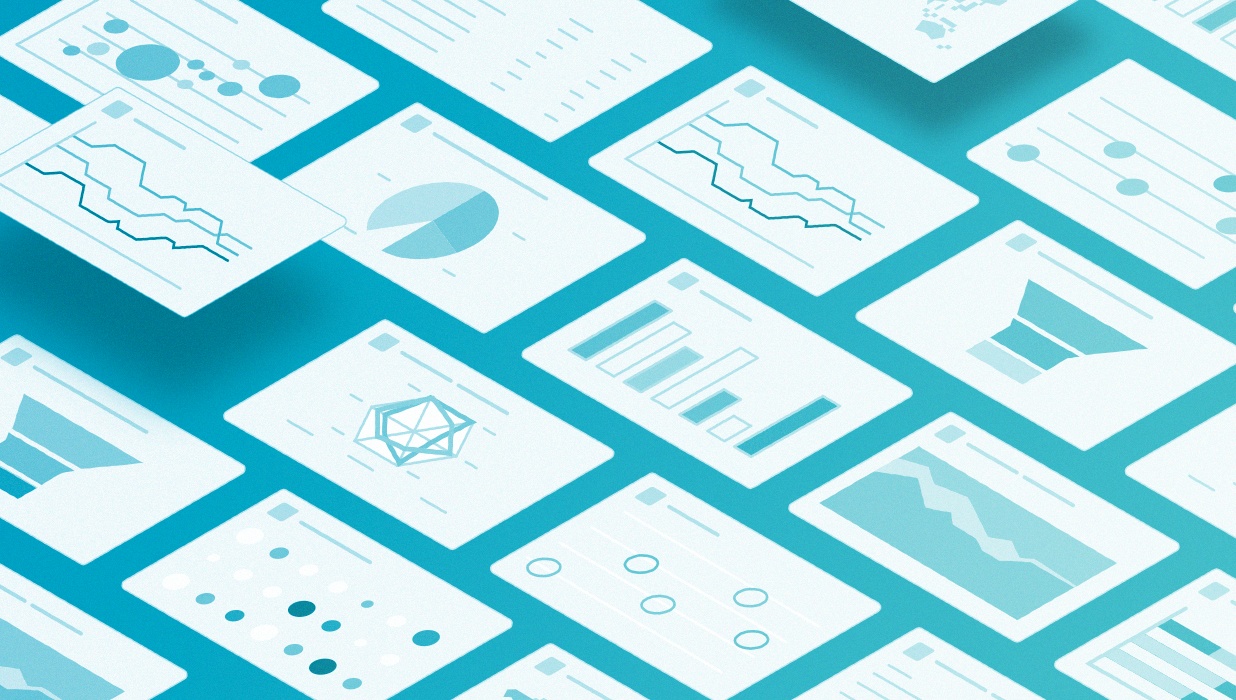
When comparing different Social Media Analytics tools, it’s easy to get lost in the jungle of possibilities. For newcomers, it is especially hard to know what features to expect of a social media analytics tool. A lot of questions need to be answered before buying such a software.
Which product offers exactly what I need? Which product might be enough for now, but not sufficient for a more in-depth-analysis some way down the road? What features are, in our opinion, highly underrated and might bring great value to users?
To answer these questions, we took a look at what our customers consider vital in social media analytics and also thought about what experience tells us as a provider about important social media analytics features.
If you think you might need more information on digital marketing before digging deeper into Social Media Analytics, you might want to take a look at our 'Social Media Buzzword' guide - quintly's a social media 101.
Many of these mentioned features are, especially for newbies to this subject, not much more than a „techy“-sounding headline, therefore we tried to characterize every single feature for you to get better understanding.
So relax, sit back and enjoy our list of the top ten social media analytics features!
What is Social Media Analytics?
Social Media Analytics is the process of collecting and visualizing social media data from different resources, such as Instagram, Facebook, Twitter and other social media networks. It gathers all structured data from selected profiles and pages and deals with specific KPIs as likes, shares, retweets or interactions that can be obtained from the platform.
1. How to share the data from your analysis? - Reports
Whether it’s a social media marketing team conference, a meeting with your superiors to update them on your recent performance or getting back to your client as an agency, there’s one thing that can make your life so much easier: social media analytics reporting.
However, these three examples might require different reports. When meeting with your team, you’re probably going to want really specific data to analyze very accurately which post, tweet, video or photo worked well, which strategy might be the best for your campaign and who important influencers in your industry are.
On the other hand, when reporting to your manager, it might be more useful to give him a broader overview over the general performance of your social media channels. When sending an update to your client, you’re going to want to present exactly those points that your client asked you to focus on.
For all this, the best thing you can get is an elaborate and at the same time easy-to-use reporting system. In quintly, you can create several dashboards for these different purposes with the metrics you need and then send these as a report. With automated or manual reports, you can save a lot of valuable time by selecting a reporting option that delivers exactly the data you need. To keep everyone updated, set up an automated social media report and get them sent into any email inbox at a daily, weekly or monthly basis.
2. Export the data from your social media analytics tool
Depending on the occasion, you might want to include your analysis data into a presentation, send it out via email, show it on a TV Screen or include it in a spreadsheet. For this, it is important to be able to have various formats.
In quintly, you can select from a wide range of exporting formats: You can export your dashboard as jpg, pdf, png, xlsx, cvs, pptx or as an online link for everyone to view. The live data link allows you to share an interactive dashboard with everybody you want to.
3. How can I compare myself to industry competitors? - Competitive Benchmarking ⚖
Benchmarking is a method in economics where every process and every function in a company is analyzed to figure out best practices. This can be done internally, for example for your Customer Success team or when you want to analyze and compare different project phases. Most commonly, though, it is done with several different companies within an industry or even across industries. The scope always depends on the specific goal. The resulting ideal practice you have determined with this method is called a benchmark.
Social Media Benchmarking is the first and foremost feature to use if you want to find out how you’re really performing with your social media strategy. Why, I hear you ask! What about interaction rates and follower growth metrics?
Well, there’s only so much you can learn by looking at how your own profile is doing. It can be much more insightful to compare your own performance to that of an industry competitor or a best practice example and then really dig into the reasons a different profile and - therefore a different campaign - is working so much better (or worse, of course).
With these insights, you’re able to adapt and adjust your strategy, just like looking at someone running 5k much faster and copying his stride length, running gear and training schedule and not just trying to improve yourself by filming your own run and trying to make something of that.
quintly applies this technique to social media analytics by giving you the possibility to compare yourself against your competition, basically offering you instant benchmarks, hence making your takeaways even more meaningful.
4. How to detect sponsored content? - Split of organic reach and paid reach
It’s not a secret that many companies use paid ads, like Instagram ads, for improving the visibility of their business. This way they can reach more potential customers and outsource some work. However, you still want to know how many leads you generated and how many you generate via your „natural“ social media activities.
For this, it would be awesome to know which page views and reactions were triggered by an organic search and which are people who visited your website via an advertisement.
quintly takes this a step further. It not only enables you to analyze where your own page views come from, but also, how many paid-for services like Facebook ads any other profile uses. That’s a pretty neat detail to find out about your competitors, right?
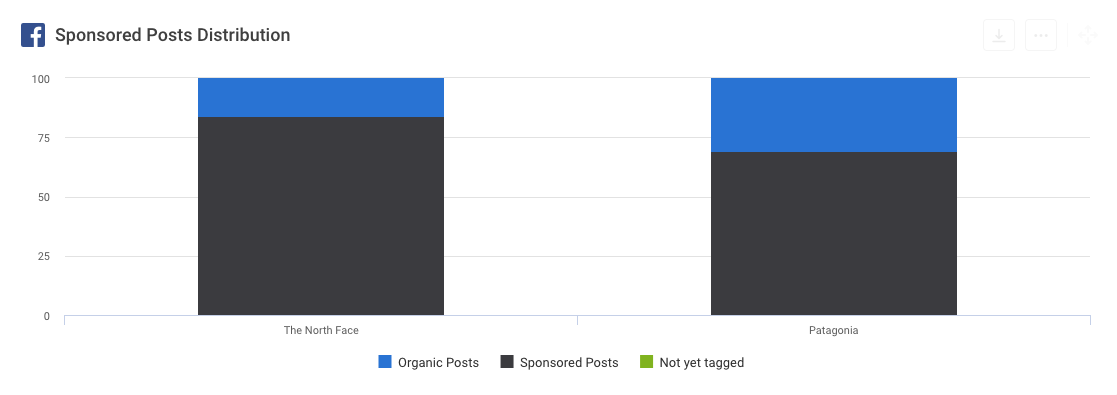
5. How can I organize my social media analysis?
There is no real limit to how many profiles you can add to your account in quintly. However, it might not be very insightful for an agency to compare a client from the clothing industry with 100,000 followers to a local barbershop with only 500 followers - and all the other clients they are analyzing.
That might end up in a graph displaying data points from a huge amount of different profiles. Needless to say that it would be difficult to interpret the data and get useful insights from the analysis. Hence, it’s an important feature to be able to sort your clients in smaller groups, for example bundling big profiles from the clothing industry in one and barbershops from Cologne specialized in red beards in another.
If you select a group, your dashboard shows you the metrics you have already selected, but with data only from the profiles in that group. Once you have sorted your profiles in groups, you can easily switch between them!
6. Personalize your social media analytics tool - Co-Labeling ✏️
Especially for agencies, it can be really nice to give the quintly software a more personalized feel. Co-labeling means that you can add your own company logo or name in the top left corner where the quintly logo usually sits. This also gives reports for your clients a much more professional look.
7. Combine your own software with social media analytics - API
Now, we are really going full tech-geek. Thick-rimmed glasses on, here’s the definition of API. The abbreviation stands for Application Programming Interface. API is the part of a software that allows and enables other programmers to connect to it. For example, as a developer of a computer operating system, you might want to provide an API to enable software engineers to develop their own applications for your system. An API is, as the name says, an interface that maps out and explains the structure of a software in order to allow programmers access.
Now, what’s it good for? Let’s assume you are a big company. You have created a software to bundle all your data. Wouldn't it be ideal for you to simply include this into your existing dashboard and work with a surface you know?
This is where a social media API comes in to save the day. To connect all data points and gain more valuable insights from available data, businesses integrate their social media data in centralized social media data warehouses and make it available for Business Intelligence (BI) solutions using services.
Recommended Reading: How to integrate quintly with Google BigQuery and Tableau.
You can, also with the help of QQL, extract the data of your analysis from quintly and include it into your existing company dashboard/software. If you want to dive deeper into this topic, why not refer to this guide.
8. Measure exactly what you want! - Custom metrics
The best social media analytics tool won’t help you if it doesn’t let you measure what you need to. That’s why we at quintly think it’s best to offer you everything we think is useful to everyone - and much more.
Allowing custom metrics to be embedded lets you add all the specific metrics you need and include them into quintly with a few keystrokes! That way, you can customize your analysis as far as possible while also making use of the over 350 metrics quintly comes with.
Also, you don’t need to be a pro software developer. With QQL, quintly’s query language, you can easily tell the tool what to measure. It is a slightly modified version of SQL and lets you access and modify our pre-packaged metrics with a few clicks. You can then add or subtract certain values that should or should not go into the metric.
For example, when you take our interaction rate metric, there are quite a few factors that go into this metric. However, depending on your industry, it might be useful to slightly modify some factors to make the data more appropriate in your specific situation. You can also create metrics that take the data from more than one social network into account. You can either do this yourself, however we are also more than happy to assist you or do the whole process for you!
9. Combine all your social media insights data
When launching a new campaign strategy on Facebook or Youtube, you probably want to measure the success of this campaign. For this, you would most likely keep an eye on metrics such as interaction rates, follower growth and - separately - look at your insight data from Facebook itself.
How awesome would it be if you were able to access your private Facebook insights data, but in the depth and specification that a sophisticated social media analytics tool offers you? You wouldn’t only see the data at a certain point in time, but also see the development in a graph, like when analyzing your other data. Well, you might not have expected it, but with our Facebook Insights Metrics, this dream comes true!
As the administrator of a profile, you can validate your access to this private data once and then include metrics such as reach, engaged users, link clicks and virtually almost every other endpoint offered by Facebook into quintly and get so much more value out of the data by seeing the development in a graph. We are proud to support almost all endpoints since we think this greatly helps you determine whether your strategy is working according to plan and whether you are using the right content to reach the right audience. Read more on our Facebook Insights metrics in this blog post.
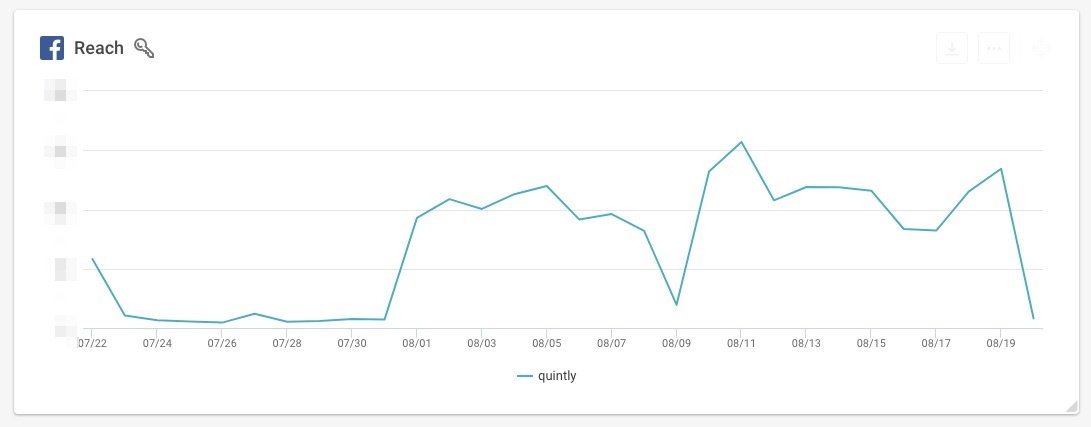
10. Analyze your Facebook video performance - Facebook Insights video views
Most brands have included videos into their social media marketing strategies - not surprisingly, since we think it’s one of the most engaging types of content if you do it right.
But, talking about engagement: when uploading a video to your Facebook timeline, it is pretty easy to see how your video is performing superficially - you can see comments, likes and shares. But does this really mirror how people are liking it? Wouldn’t it be a lot more comprehensive to also find out whether they are really watching it to the end? And if not, at which point they stop watching? Whether they might even be watching it twice?
You’re in luck - quintly released some new metrics that let you find out exactly that! As an administrator of a profile, you can, as mentioned in the section above, validate your account and include Facebook Insights into quintly. We developed several metrics such as Audience Retention, Repeat Video Views, click-to-play vs. auto-play.
Audience Retention for example lets you analyze at which time during the video there were how many views. This then lets you see what we talked about above, if everyone watches it until the end or if and when people start losing interest in your video. You can then modify your video style and content accordingly. If you want to dive deeper into this topic, take a look at our '7 Way to Get More Facebook Video Shares' post.
By the way, did you know that videos directly uploaded to Facebook perform overall better than other video formats on Facebook? Study proves: 530% more comments on Facebook Native videos.
We hope you found this list insightful and are now full of energy to explore the jungle of social media analytics features with these new insights as traveling companions. Beware of the lions, though!
Since this is a lot to take in, don’t hesitate to reach out to our support team who are always happy to help you out, should anything come up! Also, if you have any further questions on these features or on quintly in general, please feel very free to reach out to us via email or twitter!
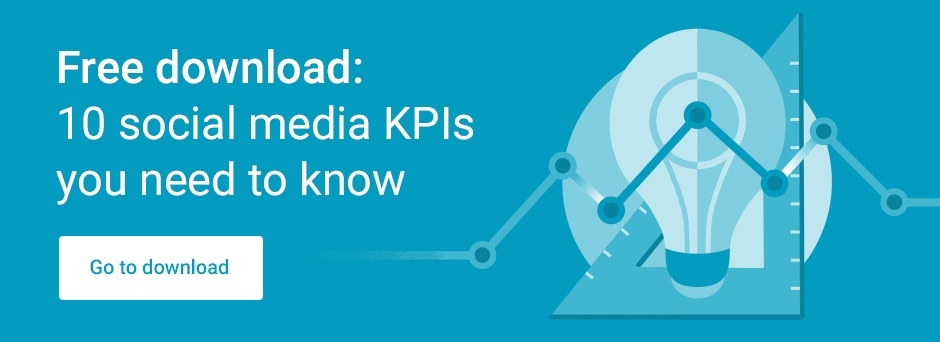
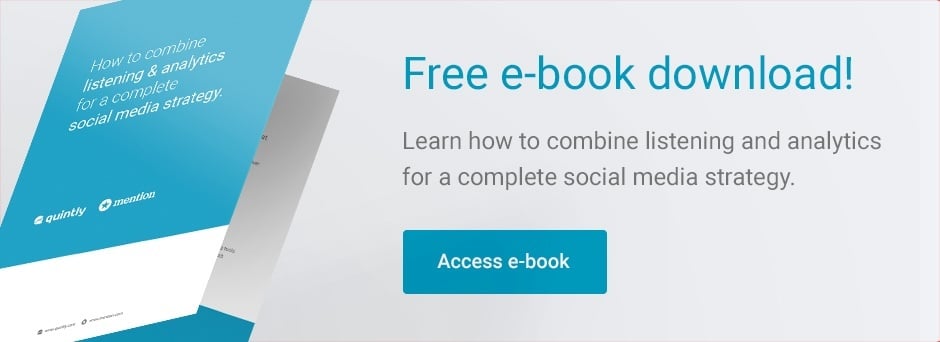

Join the conversation. Leave us a comment below!